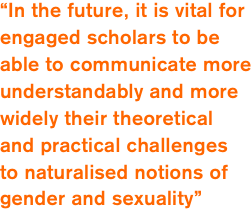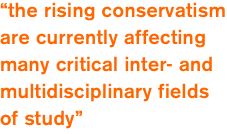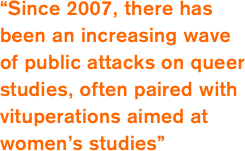| 
|  | | 
Despite aforementioned structural difficulties in providing continuous teaching and reliable funding for scholars, queer studies have also gained some public recognition. One admittedly somewhat problematic indicator of the relative public visibility of queer studies is the amount of homophobic hostility it encounters. Since 2007, there has been an increasing wave of public attacks on queer studies, often paired with vituperations aimed at women’s studies. The attacks focus on recurring themes, the first of them being the fact that in Finnish parlance gender studies is still called women’s studies. The question of naming has been turned against the discipline itself, as many of the conservative “pro-male activists” interpret the name in a literal fashion. According to them, in the departments of women’s studies only women’s lives, problems and femininities are permissible to study. Due to this gross misconception, the function of Finnish women’s studies centres as umbrella organisations for gender, queer, lesbian, critical masculinity studies and critical studies on heterosexuality, for example, has been totally missed. |  | 
| 
|  |  | In addition to this, women’s studies are eagerly depicted in these debates as ideologically undermined by feminism, and hence a prime example of those scientifically allegedly illegitimate and incredible intellectual and academic traditions which flourish outside of the natural sciences. Among them are listed humanist studies, qualitative methods and constructivist or poststructuralist theoretical stances in any field of study. For example, in the spring 2008, Helsingin Sanomat, the major newspaper in Finland, has repeatedly published antifeminist rants in the science section of the paper, while every contribution by leading professionals in women’s studies has been relegated to the more humble Letters section. Such antifeminist attacks can even get a homophobic twist, like when a Finnish professor publicly – in his column in Helsingin Sanomat – depicted women’s studies in Finland as held hostage by sexual minorities working on queer studies. Similarly hostile discussions against feminist and queer scholars are familiar to us from both Sweden and Germany.[8] |  | 
| 
|  |  | We interpret the biased debate as part of a larger ideological discussion going on in both Europe and in the US against “too political” scholarship. Such debates against women’s and queer studies in the Finnish media also function as perfect examples of the dangerously effective power of stupidity discussed by Judith Halberstam in Trikster #1.[9] It is significant how such debates in Finland have been orchestrated by turns either by fundamental science believers or by conservative advocates of men’s studies. Both have successfully used their omnipresent populism in the media to antagonise the present cultural atmosphere and to make it hostile and distrustful of women’s studies. This results in such bizarre situations as the one encountered by a colleague at the Department of Women’s Studies at the University of Tampere, who was invited to attend a public broadcasting program to discuss whether women’s studies even qualify as a scientific academic approach. The massive anti-feminist rant of the men’s studies advocates succeeded as a mode of domination as it led, in addition, to disabling the national women’s studies mailing list, an open forum thus far known for its animated but civilised discussion. |  | 
| 
|  |  | Such developments make it painfully apparent that while women’s and even queer studies have established their relative visibility in the academia, at the same time most conservative notions of gender and sexuality have prevailed in popular media and even among many scholars working in other fields of study. The gap in communication remains wide, since queer and feminist studies in Finland have been seen as distinctively scholarly work done by academics from the beginning. In the demanding process of establishing these within the Finnish universities, the most prominent publishing venues for the scholars have been referee journals and academic publications. Hence the everyday activism in popularising research has played a second fiddle. In the future, it is vital for engaged scholars to be able to communicate more understandably and more widely their theoretical and practical challenges to naturalised notions of gender and sexuality. |  | 
| 
|  |  | 
As we have seen, the ideologically antifeminist and homophobic public sentiments push women’s and queer studies into a dangerously singularised and marginal position. It is most unfortunate that this coincides with the largest restructuring experienced by the Finnish university landscape of its entire history. In 2010, there is to be a new law about the governance of the universities. This creates a situation in which the so far public universities are separated from the state both in terms of direction and financial backing. Universities no longer follow a public responsibility, but are turned into independent streamlined business corporations instead. |  | | 
|  |  | This development has been on its way already in the so-called Bologna process which has stripped single disciplines to their core mission. In the core material, critical approaches such as feminist and queer theories are often marginalised or completely eradicated from the curricula. Hence issues such as gender and sexuality are generally no longer to be found in the curricula of most of the disciplines.[10] This means that the rather successful double strategy (followed to a certain extent also by queer scholars) of having women’s studies both as a singular discipline and integrating it into other disciplines is getting more and more difficult to practise in the conservative and neo-liberal New University. This eradication process of any representatives of critical theory rides high at the same time as the universities are more and more mesmerised by the ideology of constant increase in productivity. Also teaching must be efficient, which too often gets translated as “aimed at large audiences”. The yearly intake of new students as well as the yearly quota for MA and PhD theses imposed by the Finnish Ministry of Education on the universities is unrealistically high and made even more problematic by the notorious uncertainty of an overflowing academic labour market. Nevertheless, the disciplines must produce tangible results yearly; in this case MA and PhD theses function as a currency for paying the salaries of the university staff and teachers. In the present hostile atmosphere, the public discrediting attacks on women’s and queer studies can have an unfortunate negative effect on the decision-makers in the academia and in the politics of higher education. Women’s and queer studies might appear less and less attractive to students as well. Moreover, if graduate studies in women’s, gender and queer studies are structurally turned into a professional cul-de-sac, we are now left to wonder how long it will remain possible to attract students and qualified supervisors to these fields of study. The dangers of a vicious circle are threatening women’s and queer studies: fewer measurable results, fewer resources, less teaching, fewer students, no discipline. |  | 
| 
|  |  | When quantitative efficiency is the only argument used in a new academia moulded according to business principles, it would be only consequent to react to “problem areas” by closing down “inefficient” departments and sacking the personnel. The most worrisome prospect is thus that small critical disciplines, such as women’s studies, and with it queer studies, will disappear altogether from the university landscape. It is apparent that the possible elimination processes following the rising conservatism are currently affecting many critical inter- and multidisciplinary fields of study. In several European countries this trend seems to be paired with an extra portion of hostility towards feminism, gender studies and queer studies – Finland, unfortunately, being no exception. |  | 
| 
|  |  | 
|  |  |
|

